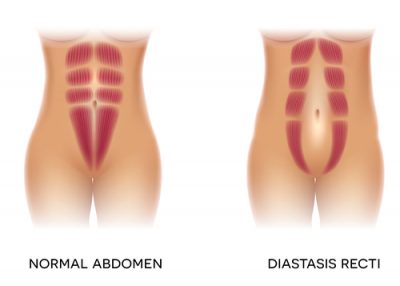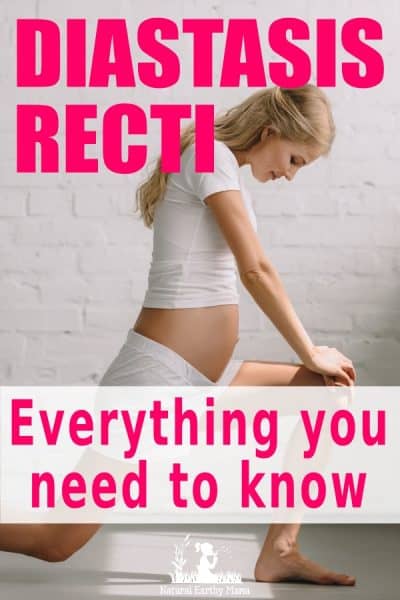 About two out of three pregnant women experience a condition called diastasis recti, or abdominal muscle separation (1).
About two out of three pregnant women experience a condition called diastasis recti, or abdominal muscle separation (1).
Pregnancy changes our bodies significantly, and diastasis recti can last well after the baby is born.
Please read: This information is provided for educational purposes only and is not intended to treat, diagnose or prevent any disease. We encourage you to make your own health care decisions in partnership with a qualified health care professional.
This post contains affiliate links, this means at no extra cost to you, we make a commission from sales. Please read
our Disclosure Statement
The severity of diastasis recti can vary from woman to woman and pregnancy to pregnancy.
What is diastasis recti?
Also known as abdominal separation, diastasis recti is where your abdominal muscles have a vertical gap between them that is greater than one inch.
This gap means that your internal organs are not held in as well as they should be, and your core is weakened.
The severity depends on how wide the gap between your abdominal muscles is. The wider the gap, the worse it is.
Signs and symptoms of diastasis recti
Many of these symptoms can point to other things as well, they can even be common after childbirth anyway. If you notice any of these things, it is worth getting your health care provider to check you for a diastasis recti gap.
- Belly bulge (belly hanging forward or sticking out when standing and a dome-like bulge when sitting up)
- Lower back pain
- Constipation
- Bloating
- Other intestinal discomfort that started or worsened after delivery
- Pelvic floor issues
- Poor posture
- Incontinence
- Core weakness
- Pain during sexual intercourse
Causes of diastasis recti
Generally, diastasis recti is caused by pregnancy. Women who are having mulitples are more likely to develop it, as are women with many children. Carrying large for dates, or having extra uterine fluid can increase the risk as well.

What makes it worse
There is not really anything you can do to prevent developing diastasis recti during pregnancy, you will either get it or you won’t.
Women with particularly tight abdominal muscles before pregnancy can also develop it.
How can I tell if I have diastasis recti?
It is very easy to test yourself to see if you have abdominal separation after having a baby.
- Lie on your back on the floor with your knees bent, feet flat on the floor.
- Slowly lift your head up about 4 inches, as if you’re about to do an abdominal crunch.
- Press two of your fingers into the flesh around your belly button. If you have diastasis recti, you will feel the walls of your abdominal muscles squeezing the sides of your fingers as the muscles contract.
- See how wide the gap is, the more fingers you can fit across the gap, the more severe the condition.
Need more info? Check out this free diastasis recti home test
Does diastasis recti heal on its own?
If you only have mild diastasis recti, it will quite probably heal on its own. If you are experiencing some of the other affects, especially pelvic floor weakness and backache, it is best to do something to heal it.
How you can help heal diastasis recti
Don’t try and spend a million hours doing sit up! Crunches have been shown to make abdominal separation worse!
Get a referral to a physio or work with a proven program that you can do in the comfort of your own home.
The MUTU system has been used by over 50,000 women who have healed their diastasis recti and bladder leakage/weak pelvic floors!
It is a 12 week program that you can do in your own home, at your own pace around you and baby’s schedule (or complete lack thereof!)
Check out the many many great testimonies here.

Is abdominal separation forever?
If your diastasis recti is only minor and you are not experiencing other side effects, it may well heal on its own. If you have more than 2-3 finger widths of gap, it is unlikely to heal by itself.
If you have a gap and don’t deliberately work to heal it, it will be there forever!
Decreasing the risk of developing diastasis recti naturally
There are a few things that have been shown to reduce the risk of developing DR but nothing is guaranteed, if you are going to develop it, you are going to develop it, it ain’t your fault.
Before you get pregnant, maintain an active lifestyle and practice pelvic floor and core strengthening exercises.
While you are pregnant avoid heavy lifting, and continue to practice your pelvic floor and gentle pregnancy-safe core strengthening exercises, modifying for a pregnant belly as required.
Wearing a belly band while you are pregnant can help support your muscles.
Eating a healthy pregnancy diet that is high in animal foods that provide protein, collagen and natural fats can also help.
RELATED POST: Pregnancy diet to prevent complications
After your baby arrives, give your belly time to heal before attempting anything that will strain the abdominal muscles like heavy lifting or doing situps/crunches or planks.
Wearing a postpartum girdle can help support your back while your muscles work their way back together.
RELATED POST: What postpartum girdle is the best?
Practicing good posture and trying to gently walk most days will help as well.
Can I have another baby if I have diastasis recti?
It is ideal if you spend some time healing the gap that you have before getting pregnant again. If you don’t manage this, another pregnancy may make it worse.
You are more likely to have trouble with back ache during the pregnancy as well.
If you do get pregnant again, keep up your safe core muscles and pelvic floor exercises and avoid heavy lifting.
Severe cases of diastasis recti can affect your ability to engage your core to push out your next baby. If you are concerned, it is best to seek help sooner rather than later in your pregnancy.
What the MUTU System Gives You
Your Support Team.
Unrivalled support from Team MUTU and their global online community, women who really get it and understand what you’re dealing with!
Effective and Safe Workouts from 12 minutes a day.
This recovery and exercise program is designed to work around your busy schedule – or lack of one!
Accountability and Motivation.
In-program tracking with tailored accountability emails, ensuring you feel motivated, supported and reassured
You will Find Your Tribe.
No judgement, no pressure, just a whole lot of love, support and guidance from your private members community ‘MUTU Connect’.
Information and Empowerment.
We’ll give you the knowledge and tools to make positive and sustainable changes, to ensure you can continue to live the life you want, feeling the way you want to.
Ready to give it a try? Check it out here.









